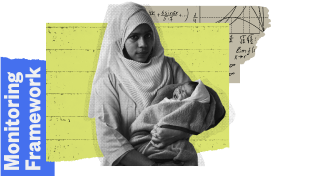
 11,653,950
Total Population
11,653,950
Total Population
A dispute exists between the Governments of Argentina and the United Kingdom of Great Britain and Northern Ireland concerning sovereignty over the Falkland Islands (Malvinas).
The boundaries and names shown and the designations used on this map do not imply official endorsement or acceptance by the United Nations.
haiti’s Population dynamics Data


Total Fertility Rate (births per woman)
Adolescent (15-19 years) Birth Rate (births per 1,000 girls)
Maternal Mortality Ratio (Per 100,000 live births)
Haiti’s national commitment
At the Nairobi Summit, the Republic of Haiti committed to broaden access to a choice of modern contraceptive methods and prioritizing comprehensive sexuality education.
Haiti’s total fertility rate (TFR) - the number of children that would be born to a woman if she were to live to the end of her childbearing years is 2.77.
TFR and unmet need for family planning is highest among rural women, women with no and primary education, and those in the poorest and second poorest households. 31.8% of married and in-union women were using a modern contraceptive method in 2016/2017, the most recent year for which data is available. Modern contraceptive use and demand satisfied with modern methods is higher for Haitian women in urban areas, among women with secondary or higher education, and in middle to the highest income households.
Haiti’s national commitment
At the Nairobi Summit, Haiti committed to prioritize targeted funding to increase and facilitate access to quality emergency obstetric care to reduce maternal mortality.
Haiti’s maternal mortality ratio remained relatively static from 2000 to 2017 and was estimated to be 480 maternal deaths per 100,000 live births in 2017,
the latest year for which most recent data is available, the highest among countries in the region. In 2022, with intensified fighting in the capital and many essential services and health facilities still damaged or destroyed in the south of the country following the 2021 earthquake, humanitarian needs are soaring: Millions of people are in need of assistance, including some 1.3 million women of reproductive age.
In 2017, the latest year for which data is available, the proportion of births in Haiti attended by skilled health personnel was 41.6%.
Among married women 15-49 years who had a live birth in the last two years, deliveries assisted by a skilled attendant were twice as high in urban areas compared with rural areas. The percentage of births with a skilled attendant is six times higher among women with the highest education compared with women with no education, and almost six times higher among women in the wealthiest households compared with those in the poorest households. As household wealth increases, so does the portion of births attended by doctors, nurses and midwives. Among women in the poorest households, most births were attended by nurses, while the majority of women in the wealthiest households had their deliveries attended by doctors.
Haiti’s adolescent birth rate in rural areas is double the rate in urban areas; it is seven times higher among girls with no education compared to those with secondary education and higher.
The adolescent birth rate is highest for women in the poorest households; it is nearly six times higher among girls with no education compared with those with secondary and higher education, and 5.5 times higher among girls in the poorest households compared with those in the richest households.
The proportion of girls who give birth before age 18 is higher for girls in rural areas than urban areas.
The majority of births before the age of 18 occurred among girls with no education, followed by those with primary education. Births among married girls 15-19 years are also higher among girls from the poorest and second poorest households. Births before age 18 are nearly 5 times higher among girls in the poorest households.
Among those 15 to 24 years, Haiti’s literacy rate is higher for women than for men.
The proportion of women who worked in the last 12 months has increased more than the proportion for men.
In 2022, the UN estimated that at least 1.5 million people in Haiti have been directly impacted by the unrest, with gender-based violence, and in particular rape, being used systematically.
The economic crisis has caused food prices to soar, while fuel is often available only on the black market. Speaking to the United Nations Security Council on 26 September 2022, UN Special Representative Helen La Lime warned that “an economic crisis, a gang crisis and a political crisis have converged into a humanitarian catastrophe”. Vulnerable populations, including pregnant women and girls, are the most impacted by restricted access to health services that are the result of this crisis.
In this context, it will undoubtedly prove many times harder to find common pathways and achieve Haiti’s ICPD25 commitments.
Without stability, security and justice, economic progress is however severely hampered. This is unfortunately becoming increasingly clear with the continued slow-down of the Haitian economy whose effects are most felt by the most vulnerable and marginalized individuals and communities.













































